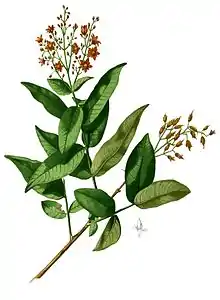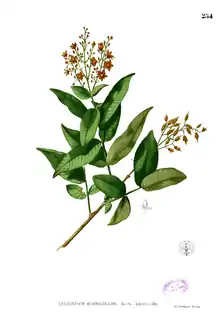| Cratoxylum | |
|---|---|
 | |
| Cratoxylum sumatranum | |
| Scientific classification | |
| Kingdom: | Plantae |
| Clade: | Tracheophytes |
| Clade: | Angiosperms |
| Clade: | Eudicots |
| Clade: | Rosids |
| Order: | Malpighiales |
| Family: | Hypericaceae |
| Tribe: | Cratoxyleae |
| Genus: | Cratoxylum Blume[1] |
| Species | |
|
See text | |
| Synonyms[1] | |
| |
Cratoxylum (or Cratoxylon Blume, an orthographic variant) is a genus of flowering plants in the family Hypericaceae, native to tropical Asia. The generic name means "strong wood", referring to the timber.[2]
Description
Cratoxylum species grow as shrubs or small to medium-sized trees. The bark, drying black, produces a yellow resinous sap. The flowers are white or pink to crimson. The ellipsoid fruits consist of three valves.[2]
Distribution and habitat
Cratoxylum species grow naturally from India through southern China to Malesia.[2]
Species
As of December 2023, Plants of the World Online recognises seven species:[1]
- Cratoxylum arborescens (Vahl) Blume
- Cratoxylum cochinchinense (Lour.) Blume
- Cratoxylum formosum (Jack) Benth. & Hook.f. ex Dyer
- Cratoxylum glaucum Korth.
- Cratoxylum maingayi Dyer
- Cratoxylum neriifolium Kurz
- Cratoxylum sumatranum (Jack) Blume
References
- 1 2 3 "Cratoxylum". Plants of the World Online. Royal Botanic Gardens, Kew. Retrieved 10 December 2023.
- 1 2 3 Wong, K. M. (1995). "Cratoxylum Blume". In Soepadmo, E.; Wong, K. M. (eds.). Tree Flora of Sabah and Sarawak. (free online from the publisher, lesser resolution scan PDF versions). Vol. 1. Forest Research Institute Malaysia. pp. 220–226. ISBN 983-9592-34-3. Archived from the original (PDF) on 27 September 2013. Retrieved 29 May 2014.
This article is issued from Wikipedia. The text is licensed under Creative Commons - Attribution - Sharealike. Additional terms may apply for the media files.
